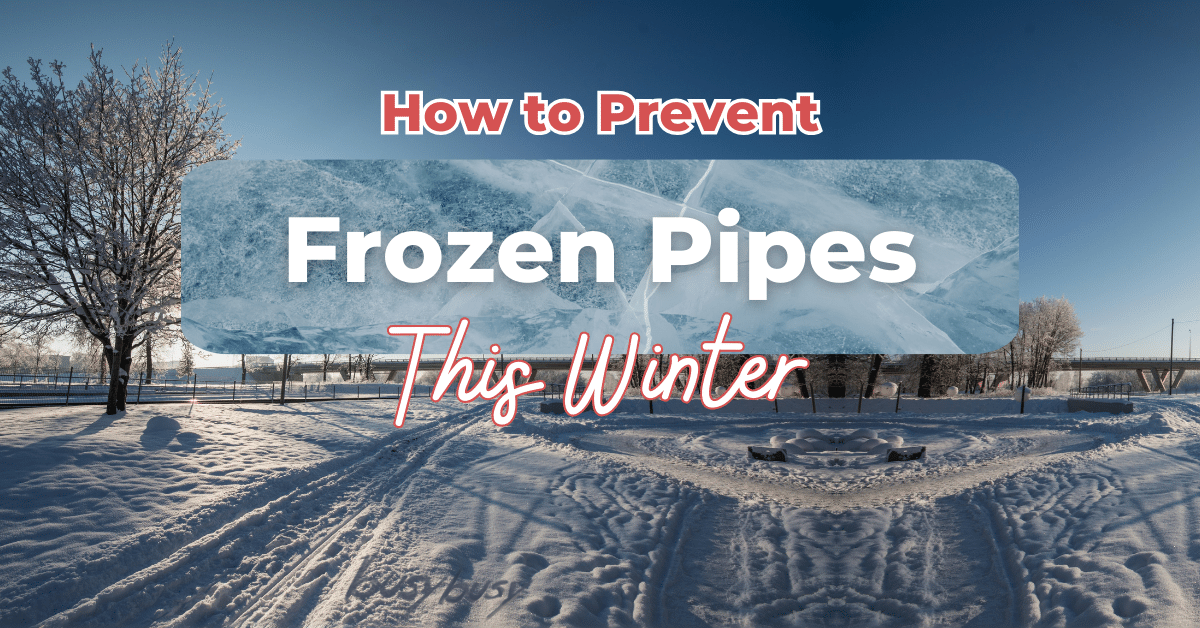
When temperatures drop, it’s important to take proactive measures to protect your home from the potential damage caused by frozen pipes. In cold weather, the water inside pipes can freeze, leading to pipe bursts and costly repairs. In this blog post, we will provide you with helpful tips to prevent frozen pipes and ensure a hassle-free winter season.
Understanding the Basics: Why Pipes Freeze and Why It’s a Problem
Water freezing inside pipes is common during the winter months, but understanding why pipes freeze, and the potential problems it can cause is crucial in preventing such incidents. This section will delve into the basics of why pipes freeze and the associated problems that may arise.
The Science Behind Frozen Pipes
When water reaches freezing temperatures, it undergoes a physical transformation and solidifies into ice. This expansion of water as it freezes is the primary reason pipes can burst. As the water inside the pipe freezes, it expands, creating immense pressure on the walls. If the pressure becomes too great, the pipe can crack or rupture, leading to leaks and water damage.
Factors that Contribute to Pipe Freezing
Several factors increase the likelihood of pipes freezing, including:
- Low Temperatures: Extremely cold weather, especially below freezing, increases the risk of pipes freezing.
- Uninsulated or Poorly Insulated Pipes: Pipes located in unheated areas, such as basements, crawl spaces, or attics, are more prone to freezing. Insufficient insulation or lack of insulation altogether exacerbates the problem.
- Exterior Wall Exposure: Pipes running along exterior walls are susceptible to freezing as they encounter colder temperatures outside.
- Lack of Heating or Temperature Regulation: Inadequate heating or inconsistent temperature control in your home can contribute to frozen pipes.
Problems Caused by Frozen Pipes
The consequences of frozen pipes can be extensive and costly. Some common problems associated with freezing pipes include:
- Pipe Bursting: As mentioned earlier, the expansion of water as it freezes can cause pipes to burst, resulting in significant water damage.
- Water Damage: When pipes burst, it can lead to flooding and water damage to your property, including walls, ceilings, flooring, and personal belongings.
- Structural Damage: Prolonged exposure to water from burst pipes can compromise the structural integrity of your home, leading to costly repairs.
- Mold and Mildew Growth: Excess moisture from water damage can create a favorable environment for mold and mildew growth, posing health risks to occupants.
- Disrupted Water Supply: Frozen pipes can also result in a complete or partial loss of water supply until the issue is resolved.
Understanding the science behind frozen pipes, the contributing factors, and the potential problems they can cause will empower you to take the necessary preventive measures and avoid the headaches associated with frozen pipes. In the next section, we will discuss how to identify the most vulnerable pipes in your home.

Identifying the Most Vulnerable Pipes in Your Home
To effectively prevent frozen pipes, it’s essential to identify the areas in your home where pipes are most vulnerable to freezing. In this section, we will discuss why certain pipes are more prone to freezing and provide guidance on how to locate these vulnerable areas.
Why Certain Pipes are More Prone to Freezing
Several factors contribute to certain pipes being more susceptible to freezing than others. Understanding these factors will help you prioritize your preventive efforts:
- Location: Pipes located in unheated or poorly insulated areas, such as basements, crawl spaces, attics, or exterior walls, are at higher risk of freezing.
- Exterior Pipes: Outdoor pipes, such as those used for irrigation or exposed plumbing, are particularly vulnerable to freezing as they are directly exposed to the elements.
- Supply Lines: Pipes that carry water from the main water supply into your home, including the main water line, are critical to protect as freezing in these lines can affect your entire plumbing system.
- Underground Pipes: Pipes buried underground, such as those connected to sprinkler systems or outdoor faucets, can be susceptible to freezing if not properly insulated.
How to Locate These Vulnerable Pipes
Now that you understand the factors that contribute to pipe vulnerability, it’s time to identify the specific areas in your home where these vulnerable pipes are located:
- Inspect the Basement and Crawl Spaces: Check for exposed pipes in these areas, paying close attention to those near exterior walls or in poorly insulated sections.
- Examine the Attic: If your home has an attic, inspect the area for pipes, especially near vents or areas with inadequate insulation.
- Check Exterior Walls: Pipes that run along exterior walls, particularly in areas with minimal insulation, are more prone to freezing. Locate these pipes and take necessary preventive measures.
- Inspect Outdoor Plumbing Fixtures: Take note of outdoor faucets, sprinkler systems, and any other exposed plumbing fixtures that may be vulnerable to freezing.
- Identify Underground Pipes: If you have underground pipes, such as those connected to outdoor faucets or sprinklers, locate their paths and ensure they are adequately insulated.
By identifying the most vulnerable pipes in your home, you can focus your preventive efforts on these areas and implement the necessary measures to protect them from freezing. In the next section, we will discuss a range of preventive measures you can take to safeguard your pipes throughout the winter season.
Preventive Measures to Protect Your Pipes
To prevent frozen pipes and ensure the smooth functioning of your plumbing system during the winter season, it’s crucial to implement a range of preventive measures. In this section, we will explore various strategies to protect your pipes from freezing.
Insulating Your Pipes
One of the most effective ways to prevent frozen pipes is by insulating them. Here are some steps you can take:
- Pipe Insulation: Wrap vulnerable pipes with foam pipe insulation sleeves or heat tape. Pay special attention to pipes in unheated areas, such as basements, crawl spaces, and attics.
- Insulate Exposed Outdoor Pipes: For outdoor pipes, use outdoor-rated insulation materials to provide a protective barrier against freezing temperatures.
- Seal Cracks and Gaps: Inspect your home for any cracks or gaps near pipes and seal them with caulk or insulation foam to prevent cold air from reaching the pipes.
Keeping a Steady Temperature in Your Home
Maintaining a consistent temperature inside your home can help prevent pipes from freezing. Follow these steps:
- Set Thermostat Temperatures: Keep your thermostat set to a minimum temperature of 55°F (12°C) or higher, even when you are away from home.
- Open Interior Doors: Keep interior doors open to allow heat to circulate throughout your home, preventing cold spots where pipes are located.
- Keep Garage Doors Closed: If you have water supply lines in your garage, ensure the garage doors remain closed to maintain a warmer temperature inside.
Properly Sealing Doors and Windows
Preventing cold drafts from entering your home is essential in protecting your pipes. Consider the following measures:
- Weatherstripping: Apply weatherstripping to doors and windows to create a tight seal and prevent cold air infiltration.
- Caulking: Inspect for any gaps or cracks around windows and doors and seal them with caulking to eliminate drafts.
- Insulate Crawl Spaces and Attics: Ensure proper insulation in crawl spaces and attics to maintain warmer temperatures and prevent cold air from affecting pipes.
Implementing these preventive measures can significantly reduce the risk of frozen pipes in your home. However, in the event of extreme temperature drops, additional steps may be necessary. In the next section, we will discuss what to do when temperatures drop significantly and how to protect your pipes further.
What to Do When Temperatures Drop Significantly
When temperatures drop significantly during the winter season, it’s important to take additional steps to protect your pipes from freezing. In this section, we will discuss what to do when faced with extreme cold weather conditions.
Keeping Faucets Dripping
Allowing faucets to drip can help prevent pipes from freezing by relieving pressure buildup. Follow these guidelines:
- Select Faucets to Drip: Identify the faucets that are supplied by vulnerable pipes, such as those located on exterior walls or in unheated areas.
- Turn on Faucets: Open the selected faucets slightly to create a slow, steady drip. This will help maintain water flow and prevent the pipes from freezing.
Opening Cabinet Doors
To expose pipes to warmer air and prevent freezing, open cabinet doors in your home:
- Identify Cabinets: Locate cabinets that house pipes, particularly those located on exterior walls or in colder areas, such as the kitchen or bathroom.
- Keep Cabinet Doors Open: Open these cabinets to allow warm air from your home to circulate around the pipes, providing additional insulation against freezing temperatures.
Using Space Heaters Safely
Using space heaters strategically can provide extra warmth to areas prone to freezing. Follow these safety precautions:
- Identify Cold Areas: Determine the areas in your home where freezing is a concern, such as basements, crawl spaces, or rooms with poorly insulated pipes.
- Place Space Heaters: Position space heaters in these areas, ensuring they are placed away from flammable objects and follow the manufacturer’s instructions for safe use.
- Monitor Space Heaters: Keep a close eye on space heaters when in use and never leave them unattended. Ensure they are turned off before leaving the room or going to bed.
By implementing these measures when temperatures drop significantly, you can provide additional protection to your pipes and reduce the risk of freezing. However, if despite your efforts, you still encounter frozen pipes, it’s important to know how to thaw them safely. In the next section, we will discuss how to detect frozen pipes and the appropriate techniques for thawing them.
How to Thaw Frozen Pipes
Discovering that your pipes have frozen can be a distressing situation, but knowing how to thaw them safely is crucial to prevent further damage. In this section, we will guide you through the process of thawing frozen pipes effectively.
Detecting a Frozen Pipe
Before you can start thawing a frozen pipe, you need to confirm its location. Here’s how to detect a frozen pipe:
- Check Water Flow: Turn on the faucets in your home. If only a trickle or no water flows from a particular faucet, it may indicate a frozen pipe.
- Inspect Visible Pipes: Examine the pipes in your home, particularly those located in unheated areas or against exterior walls, for any signs of frost or ice accumulation.
- Listen for Unusual Sounds: If you hear strange noises, such as cracking or banging, when you turn on a faucet, it could indicate a frozen pipe.
Safe Thawing Techniques
Once you have identified a frozen pipe, it’s essential to thaw it safely to avoid causing further damage. Here are some recommended techniques:
- Open Faucets: Open the faucets connected to the frozen pipe. As the ice starts to melt, water flow will help relieve pressure and prevent pipe bursts.
- Apply Heat: Use a hairdryer, heat lamp, or portable space heater to gently apply heat to the frozen section of the pipe. Start from the end nearest to the faucet and work your way towards the blockage.
- Use Warm Towels: Wrap warm towels soaked in hot water around the frozen pipe to gradually thaw the ice. Replace the towels as they cool down.
When to Call a Professional
While you may be able to thaw some frozen pipes on your own, there are situations where it’s best to seek professional assistance:
- Inaccessible Pipes: If the frozen pipe is located in a hard-to-reach area or behind walls, it’s safer to call a professional plumber to handle the situation.
- No Success with Thawing: If your attempts to thaw the pipe are unsuccessful or if you’re unsure about the proper techniques, it’s best to contact a professional to avoid causing further damage.
Remember, safety should be your top priority when dealing with frozen pipes. If you are uncomfortable or unsure about any aspect of thawing the pipes, it’s always wise to seek professional help.
Conclusion
By understanding how to detect and safely thaw frozen pipes, you can effectively address the issue and minimize the potential damage caused by freezing. However, prevention remains the best approach. By implementing the preventive measures outlined in this blog post, you can significantly reduce the risk of frozen pipes and ensure a trouble-free winter season for your plumbing system. Stay vigilant, stay prepared, and enjoy the comfort and peace of mind knowing that your pipes are protected.













